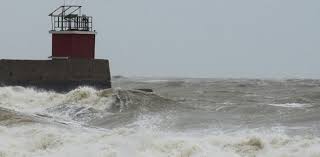F.P. Report
KARACHI: Cyclone Biparjoy slammed into the Indian coast (Jakhau port) and adjoining Pakistan-India border with powerful winds, sowing fear and prompting evacuations, but began weakening into a cyclonic storm (CS) in the early hours of Friday as it moved north.
Indian forecasters had warned that Biparjoy, whose name means “disaster” in Bengali, was likely to devastate homes and tear down power lines as it barrels through the western state of Gujarat.
The cyclone came ashore as a Category 1 storm and Pakistan’s coastal areas, including Karachi, remained largely spared.
However, according to the Pakistan Metrological Department update, the Very Severe Cyclonic Storm (VSCS) Biparjoy over northeast Arabian Sea has crossed the Indian Gujarat coast (Jakhau port) and adjoining Pakistan-India border at a distance of 135km from Keti Bandar, 160km from Thatta and 220km from Karachi. The associated maximum sustained surface winds are 100-120 km/hour, gusting 130 km/hour with sea conditions being rough/very rough in Northeast Arabian Sea with wave height 10-15 feet. The system is likely to move further northeastward and weaken into a Cyclonic Storm (CS) by 16th morning and into a Depression by 16 June evening.
Earlier, weather officials had said that the cyclone was expected to move overnight into Pakistan’s Sindh province, home to the port megacity of Karachi.
The PMD further predicted that under the influence of Biperjoy, widespread rain-thunderstorm with some heavy/very heavy falls accompanied with squally winds of 80-100km/hour likely in Thatta, Sujawal, Badin, Tharparker, Mirpurkhas and Umerkot districts till 17 June.
Dust/thunderstorm rain with a few heavy falls and accompanied with gusty winds of 30-50 km/hour likely in Karachi, Hyderabad, Tando Muhammad Khan, Tando Allayar, Shaheed Benazirabad and Sanghar districts tonight and tomorrow.
Squally winds may cause damage to loose and vulnerable structures (Kutcha houses) in Thatta, Sujawal, Badin, Tharparker and Umerkot districts.
Storm surge of 2-2.5 meters (6-8 feet) expected along Keti Bandar and surrounding which can inundate the low-lying areas.
Sea conditions along Sindh-Makran coast likely to be rough/very rough (with 2-2.5 meter tide).
The Met office warned fishermen not to venture in open sea till the system is over by 17 June.
Windstorm/rain hit several areas in Sindh
As the Cyclone Biparjoy made its landfall last night in Indian Gujarat, gusts up to 100km/h and torrential rains accompanied it.
The wind intensity in Pakistan’s Kati Bandar has increased. The electric poles collapsed and the roofs were blown off. Heavy rains were recorded in Mukli, Thatta, Badin, Hyderabad, Karachi and adjoining areas.
78,000 people were evacuated, Kati Bandar was completely evacuated.
Pakistan largely spared
Climate Change Minister Sherry Rehman has said that Cyclone Biperjoy has completed landfall in Indian Gujarat. She Pakistan was prepared but largely spared the full force.
She tweeted today: “Cyclone Biperjoy has completed landfall in Indian Gujrat. Pakistan was prepared but largely spared the full force. Sindh’s coastal areas like Sujawal were inundated by high sea levels, but most ppl had been evacuated to safe ground. Thank u to all partners in a stellar coordination effort for saving lives & keeping the lights on.
82,000 people evacuated
Earlier, Sherry Rehman said around 82,000 people had been moved from southeastern coastal areas in the face of “a cyclone the likes of which Pakistan has never experienced.”
Many of the areas affected are the same inundated in last year’s catastrophic monsoon floods, which put a third of Pakistan under water, damaging two million homes and killing more than 1,700 people.
“These are all results of climate change,” Rehman told reporters.
‘Terrified’
Storm surges were expected to reach four metres (13 feet), with flooding possible in Karachi — home to about 20 million people.
In the largely abandoned fishing town of Zero Point — so-called because of its proximity to the Indian border — 20-year-old Jaffer Ali said residents “are afraid of what is coming.”
The shanty settlement of hundreds of thatched homes was populated mainly by stray cats and wild dogs, with at least a hundred idle fishing boats tethered to a long pier running out to the ocean.
“Our worst fears are that it will come in the evening or later tonight,” Ali told AFP.
About 200 people huddled together in a single-storey health centre in Kutch district, a short distance from India’s Jakhau port, late on Wednesday.
Many were worried about their farm animals, which they had left behind.
Dhal Jetheeben Ladhaji, 40, a pharmacist at the health centre, said 10 men had stayed behind to look after hundreds of cattle crucial to their village’s livelihood.
“We are terrified, we don’t know what will happen next,” Ladhaji said.
Jayantha Bhai, a 35-year-old shopkeeper in the Gujarat beach town of Mandvi, told AFP before the storm hit that he was afraid for his family’s safety.
“This is the first time I’ve experienced a cyclone,” said Bhai, a father of three boys aged between eight and 15, who planned to wait out the cyclone in his small concrete home behind the shop.
“This is nature, we can’t fight with it,” he said, as driving rain lashed his home.
‘Widespread damage’
Low-lying roads started to flood on Thursday afternoon after hours of rain.
Gusting winds blew sheets of water that reduced visibility with a dull grey mist.
Almost all stores were closed, and shoppers had crowded the few that remained open to buy last-minute food and water supplies.
India’s meteorologists warned of the potential for “widespread damage”, including the destruction of crops, “bending or uprooting of power and communication poles” and disruption of railways and roads.
The Gujarat state government said 94,000 people had relocated from coastal and low-lying areas to shelter.
Cyclones — the equivalent of hurricanes in the North Atlantic or typhoons in the Northwest Pacific — are a regular and deadly menace on the coast of the northern Indian Ocean, where tens of millions of people live.
Scientists have warned that storms are becoming more powerful as the world gets warmer with climate change.







